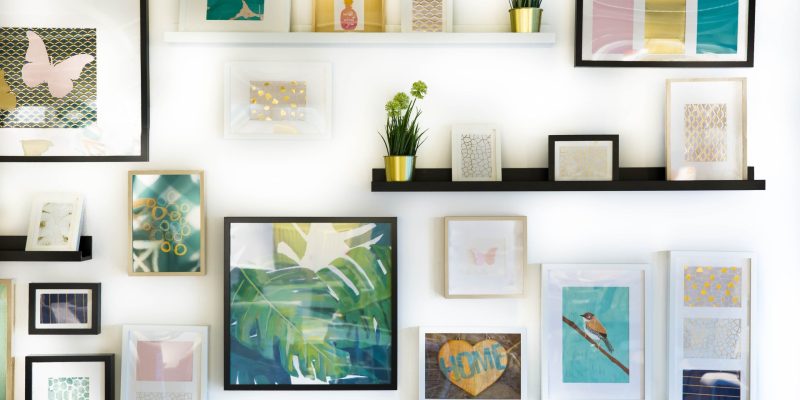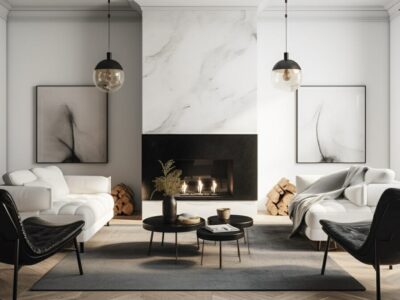Wall art or other designer wall hangings can boost the aesthetic appeal of any room in the house and set the tone for the space with plants or give it the right shade. If you have a blank area on your wall or a particular room that feels too empty, then you have a fantastic opportunity to decorate with these pieces. But what’s the best way to find art or decor that matches the rest of your interior arrangements? For many homeowners, it’s a challenge to find decorations for their walls that optimize their open space. With everything from framed photographs to felt wall panels, you have quite a few options to choose from when designing your space.
For most rooms in your house, wall art or other similar decor pieces are an accent to your furnishings and other central design elements. Before you start shopping for wall art, consider the existing design style in your space. Do your interiors bring forward a modern or contemporary appearance? Or are they more traditional? The answer lies somewhere in between for many homes, centering instead on what designers refer to as transitional design. Once you’ve identified the design style you need the piece to sync with, you’ll be ready to start shopping.
Factors to Consider in New Art Pieces
If you’re ready to peruse pieces for your wall, you may want to narrow down your options with a few key design factors. While these factors can guide you through the process of selecting wall art, they don’t have to determine your choices. If you pick items that simply look and feel right for your space, then you’ll end up feeling happy with your interior design.
Color
The color of your wall art can transform your entire space. Bright accents can lighten up a space and make it feel more welcoming. Cooler colors can instead make a room feel relaxing and calm, yet serious. A dramatic color mix within the frame can be valuable if you want your wall art to serve as a focal point. If you’re looking for more of a backdrop, stick with simple mixes instead.
Tone or Scene
What’s going on within the frame? Are you looking at a natural space or a cityscape? Photos or paintings of the environment are considerably less “busy” than a picture of a city street. From the beach to the forest, natural scenes make for the most effective, timeless additions to your space. If a room looks or feels boring, a more dramatic scene might be a better fit. You may also want to consider adding imagery that reflects the landscape of your location.
Independence of the Piece
Does the piece stand alone, or does it blend into the room’s background? Would the work look better alongside a similar selection? If you’re setting up a focal point behind the couch or the bed, you’ll need wall art that stands on its own.
Framing vs. Open Canvas
A piece set on borderless canvas is usually a better fit for the surrounding interior design style in modern or contemporary spaces. Framed photos, paintings, and posters bring more of a classical appearance and likely make the most sense for more traditional interiors.
Complexity
The complexity of the art’s design may be a determining factor for selecting wall hangings that match your space. Consider the arrangement of a movie poster. There’s a lot going on within the frame! The faces and poses on the paper are meant to look and feel action-packed. On the other hand, the works of Mark Rothko are an example of art that is altogether uncomplicated.
How Wall Art Varies Depending on Location
Your wall art should vary significantly depending on the room where you’re placing the piece. Selections for bedrooms differ considerably from the same for bathrooms, kitchens, or living rooms. Here’s a quick guide to choosing pieces that match up with each room in your house.
Bedrooms
Bedroom wall art is a chance to get creative with your selections and add a distinctive personality to the space from frisbees to bold statements. There are minimal rules in terms of color or contrast, so brighter red and yellow accents are always welcome additions. The most common location for wall art for this space is centered behind the bedframe, which means it’s essential that the piece works independently from other decor items.
Living Rooms
Living spaces, regardless of home design style, should be bright and welcoming, with an open, social atmosphere. For this reason, you may want to steer clear of the cooler colors, such as blue, grey, and black. White, yellow, and green are popular choices for this space, but this may change depending on the modernity of the furnishings and other key design elements.
Kitchens and Home Offices
Kitchens and home offices are workspaces, which means your interior design should contribute to making the spaces more relaxing. You’ll want to select colors such as blue, grey, green, and white to ensure that the room’s atmosphere stays calm and collected. For home offices specifically, you may want to include creative motivational pieces, such as framed quotes.
Bathrooms
Bathroom selections should be smaller and less intrusive, with less creative embellishment than you might see in a bedroom or home office. A few framed photos often make for an excellent design addition. Remember, you’ll need to select art that can stand up against the humidity in the space. For this reason, you’ll want to avoid anything that’s set on canvas.
Professional Assistance With Designing Your Space
If you’re not sure how to select wall art that matches your space, or you’re after a luxury look for your space, you may want to consider reaching out to a design professional. Luxury interior designers can assemble spaces with a timeless, durable appeal that will impress your friends and family. Wall art, furnishings, and other central elements are curated for your home by an expert in the craft so that the design of each room is altogether seamless.










Comments